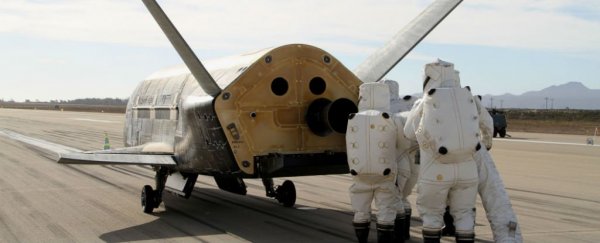An uncrewed, solar-powered military plane has just broken its spaceflight-duration record, having now spent more than 719 days in orbit around Earth.
Known as the X-37B, the space plane belongs to the US Air Force, and this is its fifth mission, Orbital Test Vehicle 5 (OTV-5). However, exactly what it's achieving on its missions remains classified.
On Monday, the plane broke the record set by the previous mission, OTV-4, which stayed in the air for a duration of 717 days, 20 hours and 42 minutes.
OTV-5 beat that record at 10:43 UTC (06:43 EDT) on August 26. We're now nearly at the end of day 719 of the plane being in orbit.
So what's it doing up there?
Well, no one's sure as yet. While the US Air Force doesn't avoid talking about the plane, they use very general terms.
Some things we do know - X-37B looks a little like a smaller version of NASA's old space shuttle, and the US Air Force has at least two of the solar-powered aircraft, which were built by Boeing.
This latest mission was launched on 7 September 2017 by a SpaceX Falcon 9 rocket and is still active.
It's not clear when it'll come down, but when it does, it'll land on a runway using its wheels.
The #X37B #OTV4 is the newest and most advanced re-entry spacecraft. Find out more about today's landing here: https://t.co/GUGgOMQiYg pic.twitter.com/HfHHVnWhYc
— U.S. Air Force (@usairforce) May 7, 2017
According to the Air Force, the X-37B's primary objectives are to research reusable spacecraft technologies for America's future in space, and to conduct experiments that can be returned to, and examined, on Earth.
Beyond that, officials haven't given up much actual dirt on the specifics of its orbital experiments.
In the past, that's led to fervent speculation that the military might be testing an EM Drive in space – a hypothetical fuel-less propulsion system that's been studied by NASA, and which China claims it's already testing.
Other speculation has suggested the Air Force might be using the X-37B for weapons research or orbital surveillance operations – although back in 2010 the Air Force denied that the program involved any "offensive capabilities".
"The program supports technology risk reduction, experimentation and operational concept development," a spokesperson said at the time.
Regardless of what the plane's mission is, it was initially only designed for an orbit window of 270 days, so the fact that it's been able to more than double that time is a pretty big win for solar-powered aircraft.
Beyond that, we unfortunately can't tell you much, other than we'll be keeping an eye on what the space plane does next.
